Winning
on points. Not the maximum image, just the maximum number of
Really Good Images under the widest range of image challenges.
I would kick none of the final four out of bed for eating crackers.
All would be welcome as the only camera with me on a trip. In
the end, the decision to declare a winner came down to very subjective
points. Every camera had drawbacks, none were perfect. One proved
itself under more varied conditions and actually brought back
more good images than the others based on criteria of storytelling,
ease of composition in light and darkness, angles of view, playfulness
(think intentional blur), control and portability. And the winner
is...

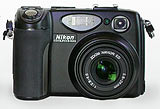 For meritorious service
in the greatest range of shooting situations, the camera that
edged ahead of the others was the Nikon Coolpix 5400. Its compact
size, wide zoom, special features and extensive controls made
it the winner, closely followed by the Sony DSC-F717, Sony DSC-V1
and Nikon Coolpix 5700 in that order.
For meritorious service
in the greatest range of shooting situations, the camera that
edged ahead of the others was the Nikon Coolpix 5400. Its compact
size, wide zoom, special features and extensive controls made
it the winner, closely followed by the Sony DSC-F717, Sony DSC-V1
and Nikon Coolpix 5700 in that order.
Here's
a 5400 Victory lap (Victory Tower, Berlin):
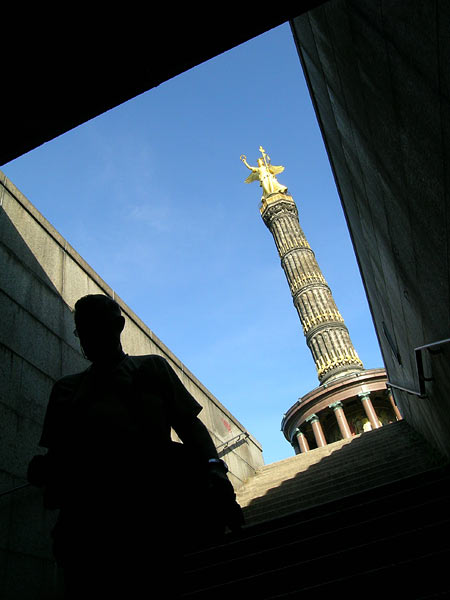 _
_
 _
_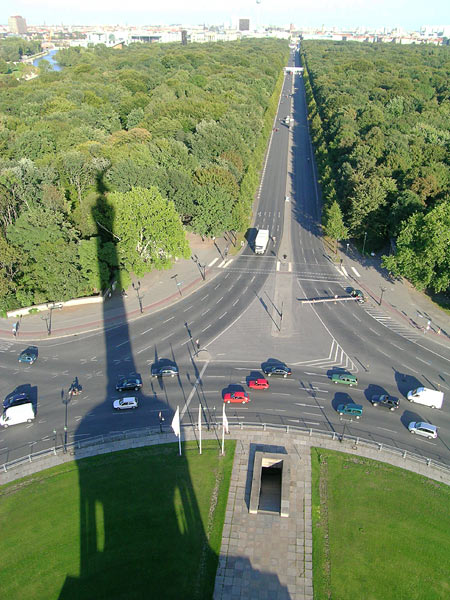
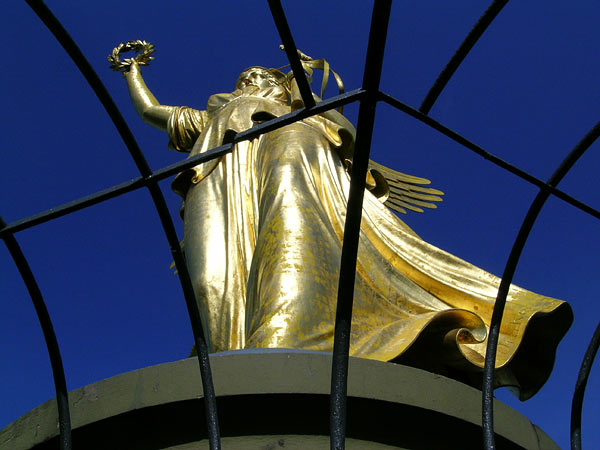
Interiors,
low light captures with BSS, wide subject capture, flip out monitor,
long battery life, good physical grip and full-daylight external
monitor viewing all contributed to the success of using the 5400.
With a sharper tele zoom it would have been farther out front
of the others, it just won on points.
Image quality
top honors went to the Sony cameras.
 The Sony DSC-F717 might
have walked off with the prize if it had been outfitted with
a 28 mm wide zoom or BSS, it was that close.
The Sony DSC-F717 might
have walked off with the prize if it had been outfitted with
a 28 mm wide zoom or BSS, it was that close.
Its exposures
were less dead-on compared to the Nikon models, but its extra
dynamic range allowed even slightly over-exposed images to be
brought back to fully normal looking shots. "Orange Drink,"
left, is an example.
Everything
on the camera is purposeful. The long barrel puts you in touch
with zoom and focus controls easily. One wishes that the external
monitor was more useful in bright sun.
The Sony
DSC-V1 isn't as fast or long as its older sibling, but the pictures
are just as long in dynamics and sharpness.
A swivel
monitor may sound like an embellishment to those whose camera
doesn't have one, but this camera was edged out of second place
due to a lack of one. Many of the candids seen in this report
were only possible through use of the swivel monitor. Its monitor
also was difficult to read in full sunlight.
(How strange
that Sony introduced a "transflective" monitor with
the DSC-F505 but abandoned it for subsequent cameras and Nikon
introduced one on their CP5400 without a whiff of fanfare.)
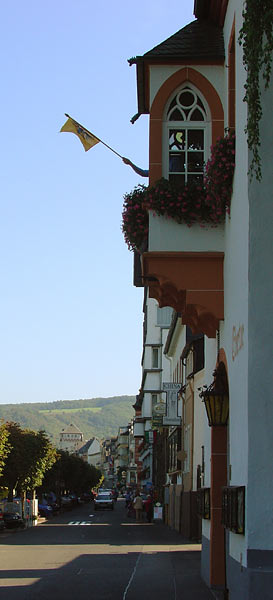 Like
the 717, the V1 needs something like Nikon's BSS. It can focus
in light that would give the Nikons fits, but it can't stabilize
the camera via luck, the way the BSS feature does.
Like
the 717, the V1 needs something like Nikon's BSS. It can focus
in light that would give the Nikons fits, but it can't stabilize
the camera via luck, the way the BSS feature does.
The Nikon
Coolpix 5700 drops to fourth not because it lacks zoom range
or sharpness, but compared to the Sony cameras it doesn't quite
hang on to the image dynamics as well, doesn't manually focus
with ease or certainty--or even a hint as to how far from the
camera the focus is, numerically, isn't as fast to power up,
doesn't have the photographer-friendly control ergonomics and,
let's face it, it's a three dimensional, non-pocket lump. Sure,
it's smaller than the Sony 717, but at least that camera lets
you zoom and/or focus with options like holding focus on a subject
while zooming out to frame the shot.
It's worth
noting that any one of the cameras I traveled with would bring
back large numbers of really fine images. Depending on how much
low-light or long tele shooting you do, your own conclusions
might have been quite different from mine.
 The single greatest criterion
for making this choice wasn't something that was decided before
shooting began, but it ends up being stated something like this:
When I reach for the camera, which one gives me the most frequent
confidence that I'm going to get the shot? In fact, all of them
usually gave me what I was looking for, but the 5400 gave it
to me most often.
The single greatest criterion
for making this choice wasn't something that was decided before
shooting began, but it ends up being stated something like this:
When I reach for the camera, which one gives me the most frequent
confidence that I'm going to get the shot? In fact, all of them
usually gave me what I was looking for, but the 5400 gave it
to me most often.
Next time,
new cameras will be on the trip. Sony's 8-megapixel DSC-F828
has the wide zoom position I crave plus manual zoom and focus.
Like the current models, it allows capture at about 80% scale--a
proven memory card saving feature. And its new chip design promises
still greater dynamic range.
Will a
camera from Nikon or another manufacturer beat it to the finish
line? Stay tuned.
PS: The ultra wide bend
in the Rhine shot at the top of this article? Two hand-held frames
from the CP5400, butterflied (bow tied?) out into a panoramic
in Photoshop. The final image was well over 4500 pixels wide.

Other pages
to visit:
Nikon
CP5700 Gallery.
Nikon
CP5400 Gallery.
Sony
DSC-F717 Gallery.
Sony
DSC-V1 Gallery.
Travel
Front Page.